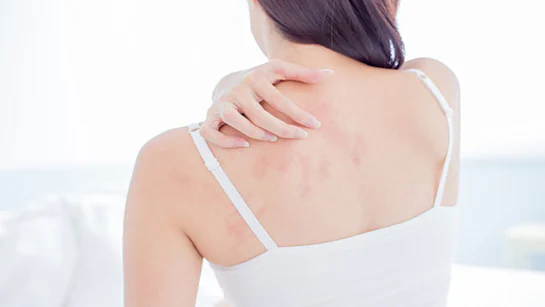Sweat Causing Rashes or Discomfort? Try These Breathable Fabric & Hygiene Fixes
Have you ever, at the end of a hot, humid day, found that your skin was red, itchy, and had rashes in places you didn’t expect? Too much sweating not only makes you feel uncomfortable, but it can also irritate your skin, cause a bad body odor, and even result in pain due to chafing. The unexpected source of the problem is, however, not always just the sweat but also what you wear and how your skin can breathe. Needless to say, tight, synthetic fabrics and bad hygiene habits will exacerbate the condition as they will both trap moisture and heat. In fact, studies show that prolonged exposure to sweat soaked clothing can increase the risk of skin infections like folliculitis and intertrigo. A few small changes like choosing breathable clothing and adjusting your hygiene routine can make a big difference. Let’s first find out why sweat irritates our skin in the first place before going on to the solutions. This understanding is the first step to getting real relief.
Quick information in this blog
Why Does Excessive Sweating Irritate the Skin?
Sweat is the body’s natural method to get rid of heat, however, if there is too much of it, especially in a hot and humid atmosphere, the body can be affected in a number of ways. It is not the sweat that is the problem but the fact that if it stays on your skin for a long time or is mixed with bacteria, dirt, and friction, it will be detrimental to your skin.
That’s the following chain of events.
- Moisture Buildup: When sweat is not allowed to evaporate quickly (because of wearing tight clothes that are not breathable), it results in the skin being covered with a layer of moisture which is conducive to the formation of irritations and even the growth of fungi.
- Bacterial Overgrowth: While sweat removes toxins, it is also the main source of bacteria that live on the skin. These bacteria thrive by utilizing sweat as a resource. As the bacteria multiply, they can clog pores and cause infections such as folliculitis or acne.
- Friction and Chafing: Regions like armpits, thighs, and below the breast are the most sensitive. If the rubbing is combined with the sweat, it results in friction, a red rash that may sting or burn.
- Heat Retention: When synthetic fabrics are employed heat conduction is hindered and therefore the skin is not able to “breathe“. This raises the internal temperature which, in turn, makes the body sweat more and consequently leads to more irritation.
It is very important to be able to identify these problems at their roots. Once you are aware of the real nature of the condition, it becomes easier to find just the right steps that will lessen the discomfort and at the same time protect your skin from further damage.
The Role of Fabric: What You Wear Matters More Than You Think

Clothing has a significant effect on your skin, as it doesn’t only cover your skin it also interacts with it throughout the day. When you perspire excessively, the fabric you wear can either be in harmony with your skin’s natural cooling process or it can become a barrier that causes heat and moisture, and thus, irritations get worse. Therefore, your fabric not only is a style choice but also an issue of skin health.
The way fabric is the king in the handling of the sweat caused discomfort.
- Polyesters have an artificial nature hence they lose air permeability no matter the fabrication they have, thus becoming extremely hot and sticky. Things like polyester, nylon, and rayon are synthetic materials that often stick to the skin and make it trap perspiration. Besides, these fabrics do not provide enough airflow, which leads to moisture being trapped near the skin, and therefore, it becomes sticky, gets rashes, and even develops fungal infection gradually.
- However, cotton, bamboo, and linen are incredibly breathable, and they give the air the possibility to move around thus decreasing the heat in the body. Furthermore, these fabrics will take up the moisture and will utilize it for faster evaporation thereby helping the skin stay dry and reducing the chances of getting chafing and redness.
- By wearing tight underarms, tight thighs, or tight lower backcloth, friction and heat will increase, and the heat may result in skin irritation worsening. Loose-fitting clothes not only can reduce the number of contact points, but they also allow the skin to breathe and therefore, they can prevent the rubbing.
- Also, for people who have a very active lifestyle, such types of fabrics which can wick away the moisture coming from the sweat off of the skin and dry up faster than regular cotton (such as athleisure) are helpful. Such fabrics that are good for sports or prolonged travel in hot weather will work out the best and will be practical.
Opting for airy, non restrictive clothes fabricated from natural fibers is not only about comfort but also the easiest and most efficient means of keeping your skin safe from the effects of sweat. Minor modifications in your clothing can contribute greatly to the betterment of your skin condition throughout the day.

When to See a Doctor About Sweat Related Skin Issues?
There are times when you may be very careful with fabrics and hygiene, but still, the irritation that you have doesn’t disappear, it may even become worse. If you find that you have rashes that persist and don’t get better, detect unusual odors, or your skin starts to leak, crack, or feel like it’s burning, then it’s the moment to have a doctor do the check up. Such symptoms can be the indication of a more serious condition like a fungal infection or, in fact, hyperhidrosis which is a disorder of excessive sweating besides the normal. When I repeated the incident, I didn’t think the rash under my arms was going to need treatment and only used some cooling ointment. And it turned out, I required prescription treatment. So should you find that something is not quite right or it keeps happening, it’s better not to wait. Just a brief session might, in some cases, be enough to eliminate the discomfort that has been bothering you for weeks.
Daily Hygiene Habits That Make a Difference
When you have a problem with excessive sweating, even the least of the hygiene habits that you are not aware of can be the reason to cool your skin if it works on your skin or it can be the reason to worsen skin condition. This is not about using a lot of harsh products, but it is about being consistent and smart with what your skin needs.

- Shower Promptly After Heavy Sweating:
Try to do this as soon as possible after a workout, a long walk, or a journey in a humid atmosphere. Sweat that remains on the skin for a long time gets mixed with bacteria and may clog the pores, which in turn may cause irritation or the appearance of acne.
- Use a Gentle, pH-Balanced Cleanser:
Do not use harsh soaps or highly perfumed body washes as they may remove the natural barrier of your skin. Instead, choose mild non-comedogenic cleansers that will not dry the skin while cleaning.
- Pat Dry, Don’t Rub:
After taking a shower, wipe your skin carefully with a soft towel and do it especially in the areas where you sweat most, such as underarms, thighs, and under the breasts. Rubbing will cause friction and irritation will get worse.
- Keep Sweat Zones Extra Dry:
In places where sweat is likely to gather, use a little bit of powder without talc or use anti-chafing balm. This way you get rid of moisture and at the same time, you reduce the skin friction.
- Change Clothes Regularly:
Stay away from damp clothes if you have been sweating a lot during the day. Take a spare top with you and change into dry clothes so that you don’t trap the sweat against your skin.
Those small hygiene changes can become your skin’s new best friend by calming it down, keeping it clean, and making it less reactive, even on the hottest days.
Mistakes That Make Sweat Rashes Worse
Honestly, even though they do not intend to, patients of mine have displayed such behaviors that have resulted in them having sweat rashes that are even worse. The one most common mistake that comes to my mind is definitely those who re-wear their sweaty clothes, particularly gym wear, without considering the fact that the clothes are actually wet. Such moisture gets covered with bacteria and thus, it can irritate the skin even more.
In addition to that, over-cleansing is going to be a problem as well. Some of the patients tend to scrub their skin several times a day with the use of harsh soaps, however, it is going to lead to the loss of natural oils and therefore, the skin barrier will be compromised. Besides that, if strong deodorants or antiperspirants are applied to the places of broken or irritated skin, stinging can happen which may result in inflammation and if the case is severe even chemical burns appear. The major point is however to be clean without being harsh: habitable, wicking clothes every day, mild cleansers, and allowing your skin to get better without aggressive products.

Final Thoughts
It’s no news that residing in a hot and humid place poses a number of difficulties, however, skin irritation caused by sweat should not be one of them. I have experienced firsthand how changes as simple as using breathable fabrics and adhering to a few basic hygiene practices can have a tremendous effect on the comfort and confidence of people. You can get rid of the problem without ointments that cost a fortune or products that contain harsh ingredients. What your skin really demands is just the liberty to breathe, gentle treatment, and a little bit of daily consciousness. Clothes and hygiene habits can be your best allies or worst enemies depending on whether you are traveling in a sticky environment or just trying to keep comfortable at home. You are fully equipped with everything you need to make the right choices and to feel comfortable in your skin every day.
FREQUENTLY ASKED QUESTIONS
Which fabrics are best for preventing sweat irritation?
Natural, breathable fabrics such as cotton, linen, and bamboo are a good choice. These materials allow air to circulate, soak up sweat, and reduce friction just great for hot weather.
Is it okay to use talcum powder to stay dry?
You might consider using powders that are free from talc, especially in areas that are very sensitive. Talc-based powders, for example, tend to cause pore blockage or irritation in some cases.
Can sweating too much actually cause an infection?
Indeed. Sweat, in combination with bacteria, and if it gets trapped under clothes that are tight, it can become hot and moist, the perfect environment for growth of the pathogens. This will cause folliculitis, fungal infections, or intertrigo.
I shower twice a day. Is that too much?
No, not really. Make sure you use a gentle, pH balanced cleanser and don’t scrub too much. The manner in which you clean is more important than the frequency of cleaning.
